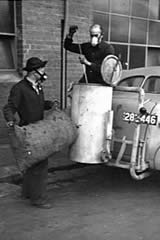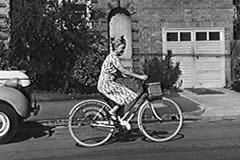This interesting link from the Australian war memorial gives as a historic insight into petrol rationing during WW2, the public debate, conflicts between commercial and private interests, fighting between States and the general political and legal minefield in a democracy faced with fuel shortages. It is doubtful whether governments and the public are better prepared now then they were then. And Australian cities are much more oil dependent now. Extracts:
Journal of the Australian War Memorial
Petrol rationing in Australia during the Second World War
{1} At the start of the Second World War Australia was lamentably unprepared for conflict, especially with regard to supplies of petrol.
{2} The realities of war started to bite when Britain applied pressure on the Australian Government to reduce petrol consumption in order to assist with Britain’s foreign exchange problems
{3} Grasping at ways to reduce consumption and hoarding without imposing rationing, the government decided an alternative would be to encourage motorists to use gas producers
{4} The problem with getting motorists to switch to gas producers was that they were still a relatively new and largely unknown device
{5} Looking for other ways to reduce petrol usage, Cabinet considered increasing the duty on petrol, conjecturing that a higher price for petrol would automatically reduce demand.
{6} Commercial firms were willing to go along with the idea that pleasure-seeking private motorists should pay more than businesses for petrol, on the premise that industry should not be called on to make sacrifices
{7} There was another consideration, however, as the Comptroller-General acknowledged when he stated in his report that a higher price for petrol “would be unfair to the man of smaller means … [and may] be far more drastic than would be the case under petrol rationing.
{8} All sections of the motor industry lobbied concertedly against any form of petrol rationing, claiming that rationing would lead to wholesale dismissals and economic instability in the motor industry
{9} The sheer vehemence of the outcry against petrol rationing left the government floundering.
{10} A commonly expressed belief was that “the government needed to be stirred up” and made to be more decisive.The government position was that the people were “still mentally unprepared for war”, and that burdens, such as petrol rationing, would have to be introduced with “exceptional care”
{11} The Commonwealth Oil Board attempted to push the government into implementing petrol rationing when supplies dwindled, as tankers were increasingly diverted from Australia
{12} Estimating that it would take at least eight weeks to formulate a scheme and set up the necessary infrastructure, 1 September 1940 was nominated as the starting date.
{13} Nevertheless, the decision to ration had been taken. The immediate problem was how rationing was to be achieved. No Commonwealth-wide organisation existed that was capable of handling it. Nor were accurate statistics held regarding consumption that could be used to devise a ration scale that would reduce usage
{14} In order to get rationing implemented in the shortest possible time any suitable existing organisations had to be used.
{15} The scheme finally devised for petrol rationing was complicated, and the paperwork was profuse
{16} To obtain ration tickets applicants had to complete and present an “Application for Ration Tickets” every time tickets were required.
{17} The first issue of ration tickets had a currency of six months. After that, issues were made every two months, with the currency period also being two months. Bi-monthly issues facilitated frequent design and colour changes in order to frustrate counterfeiters
{18} A weakness of the issuing system was that there were no appropriate safeguards to stop an issuing officer falsifying forms, as the forms were not returned to State Liquid Control Boards
{19} Misleading information given on applications in order to obtain greater allocations created problems in setting a ration that would reduce consumption. However, greater problems arose from figures provided by motor trade organisations, who claimed that actual mileage was considerably greater than the estimates held by the government
{20} Because statistics were hastily cobbled together, the Commonwealth Oil Board knew it was unlikely that the required reduction in consumption would be obtained without trial and error
{21} The organisation of petrol rationing took longer than anticipated and the start was delayed until 1 October 1940
{22} As this was Australia’s first experience of wartime rationing it was inevitable that it would have a rugged inauguration. Within days, the premiers of New South Wales and South Australia demanded a ration revision because of complaints directed at their governments when essential services were disrupted while private motorists seemed to have petrol to spare
{23} The furore over rationing overflowed into the 1940 election campaign, as the government had feared would happen, and Prime Minister Robert Menzies was forced repeatedly to defend the government’s decisions on rationing
{24} When parliament resumed after the election the Opposition used the general discontent about rationing to berate the government
{25} This statement mirrored advertisements used in motor industry lobbying during the election campaign that proclaimed “An all in war is impossible on rationed petrol” and “Death to Industry. Facts about the proposed petrol rationing”
{26} The petrol position deteriorated. Not only did the government have to cope with disgruntled consumers, but also tanker deliveries became more and more disrupted and supplies lessened alarmingly
{27} This information [Britain intending to run Australian stocks run down] created consternation among Australian officials. The High Commissioner was asked whether the United Kingdom realised that at least half of the stocks within Australia were required as an Army reserve.
{28} To aggravate matters even further, there was, for some unknown reason, an uneven allocation of tankers between the various petrol companies.
{29} The whole petrol supply position was not helped by the fact that rationing was “working out very badly”
{30} When sales figures became available for the first six months of rationing in mid-April, they showed that rationing had only reduced consumption by 16 per cent instead of the targeted one-third
{31} The petrol outlook became even bleaker during May 1941 as tanker movements became more uncertain and it was estimated that by 31 July 1941 stocks would have fallen to 50,573,000 gallons.
{32} As usual, Cabinet took time deliberating, and in the meantime things rapidly got worse. Before Cabinet had reached a decision, the Minister for Supply was told by the Oil Fuel Control Board that even harsher cuts should be made, as priority would have to be given to the importation of aviation fuel during June
{33} These cuts [1,000 miles for private motorists] commenced from the ticket issue on 1 August 1941
{34} The new rations were not accepted without complaints. It seemed the general belief was that the war could be fought without any sacrifices. People inundated the Prime Minister with letters complaining about rationing. They complained about the apparent wastefulness of public authorities, about not having enough petrol to go to church, about not being able to go fishing, and about not being able to visit relatives
Fuel rationing caused Australians to change their methods of transport.
{35} When the proposal to cut taxi allowances from 100 gallons to 22 gallons per week became public knowledge in September 1941 the rigors of petrol rationing really hit home
{36} The reasons for the unpopularity of gas producers were obvious. They were inconvenient, they were cumbersome, they were not particularly efficient, and their weight increased wear on tyres (which were in short supply). As well, refuelling with charcoal was a dirty process. No amount of attractive propaganda could overcome these intrinsic shortcomings
{37} Attempting better management of petrol supplies the government proposed the “pooling” of petrol under its control as pooling would enable more efficient use of the storage owned by the various oil companies
{38} Victory over Japan raised expectations that rationing would be promptly abolished, but such hopes were in vain. Fundamental problems remained. Australia still obtained the bulk of petrol supplies from dollar areas and Britain still expected Australia to limit petrol usage to save dollars to help reduce Britain’s outstanding dollar debt
{39} The British Government continued to urge Australian authorities to save petrol even though the Australian motorists’ ration was 50 per cent less than private motorists received in the United Kingdom and New Zealand
{40} While the Australian Government was prepared to go along with the United Kingdom regarding petrol restrictions, entrepreneurs were not, and the government’s authority to extend the Defence (Transitional Provisions) Act, which provided the power to keep rationing in force, was challenged in the High Court in Wagner v Gall
{41} Chaos followed. People hoarded, and petrol supplies became so scarce that primary production was seriously hindered; businesses were at a standstill, and industries were disrupted.
http://www.awm.gov.au/journal/j36/petrol.asp

